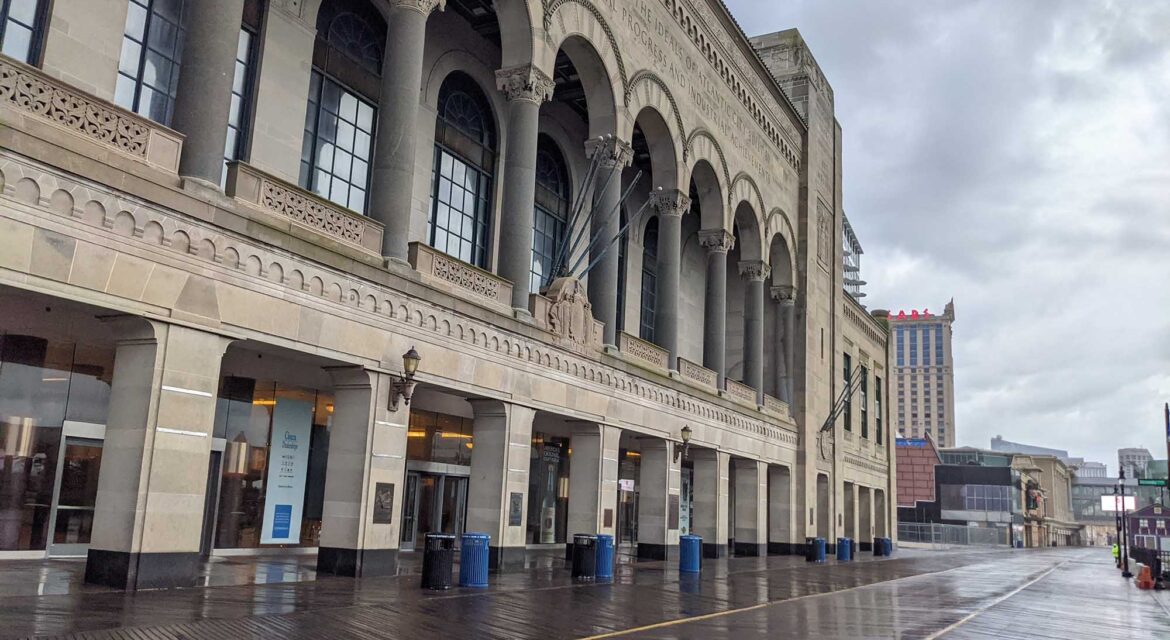 The Atlantic City Boardwalk is both a feature and a destination that defines the past and present of Atlantic City, New Jersey. Four miles long and running along the edge of the Atlantic Ocean, the Boardwalk provides stunning views on one side and access to the culture and entertainment that have come to define the region on the other, creating experiences for audiences that have enabled connections across the eras.
The Atlantic City Boardwalk is both a feature and a destination that defines the past and present of Atlantic City, New Jersey. Four miles long and running along the edge of the Atlantic Ocean, the Boardwalk provides stunning views on one side and access to the culture and entertainment that have come to define the region on the other, creating experiences for audiences that have enabled connections across the eras.

From Beach Resort to Gaming Hub
 The first of several versions of the Atlantic City Boardwalk was constructed in 1870 as a solution to keep the sand out of beachfront hotels and railroad passenger cars. An ordinance said no commerce of any kind was allowed within thirty feet of the walk but that rule was completely eliminated by 1883. Rolling Chairs were introduced in the 1880s and were at one time the only vehicle allowed on the Boardwalk.
The first of several versions of the Atlantic City Boardwalk was constructed in 1870 as a solution to keep the sand out of beachfront hotels and railroad passenger cars. An ordinance said no commerce of any kind was allowed within thirty feet of the walk but that rule was completely eliminated by 1883. Rolling Chairs were introduced in the 1880s and were at one time the only vehicle allowed on the Boardwalk.
Numerous storms and hurricanes over the decades saw several different versions of the Boardwalk, each larger and containing additional elements, such as railings. The 1916 design contained the herringbone board pattern, supportive steel pilings and forty-foot steel beams that define the modern Boardwalk.
The beach resort identity of the city was further fueled by the Boardwalk for many decades, allowing it to become everything from a set for filming productions to a destination for stars across the world. Casino gaming that came in the 1970s redefined this identity in a major way, with the Boardwalk being a central aspect of this redefinition.
Mentioned as Atlantic City’s greatest and most romantic attraction, the Boardwalk provides residents and visitors with access to the city’s many attractions. Serving as the literal backbone of the community, it hosts year-round parades and events, attracting the attention of audiences from all over.

Attractions, Engagement and Opportunity

During the annual St. Patrick’s Day Parade, bagpipers, marching bands, Irish steppers, floats and more make their way down the wooded runway of the Boardwalk. The Rock ‘n’ Roll Atlantic City Marathon, IRONMAN 70.3 Atlantic City, the Atlantic City Easter Parade, Atlantic City Airshow and the Boardwalk Summer Entertainment Series are just a few of the other events that take place across the year and are defined by the Boardwalk.
These events are in addition to the regular lineup of activities with offer world-class shopping, dining and entertainment all along the Boardwalk, providing shoppers with access to local shops that sell items unique to Atlantic City such as saltwater taffy, fudge and Atlantic City-themed souvenirs and gifts.
The notoriety of the Boardwalk has enabled it to cultivate specific attractions like Boardwalk Hall, House of Blues, and the Ripley’s Believe It or Not! museum. Numerous piers also define the experiences that audiences can have all along the Boardwalk, the most famous of which is the Steel Pier. Billed as the “Showplace of the Nation,” it was one of the most popular venues in the nation for much of the 20th century and still operates as an amusement pier. Others like the Garden Pier have known as the arts and cultural center of the Boardwalk, highlighting what kind of opportunity it contains for further development.
All of these activities highlight what it can mean for an attraction to both serve as and become a landmark for an entire city and nation. Providing access to hotels, resorts, shops, casinos and more, it showcases what it can mean to experience the culture of a city and nation on multiple levels.

An American Icon
 In becoming an American icon, the Atlantic City Boardwalk provides residents and visitors with access to the best things the city has to offer. Whether people are riding the iconic Rolling Chairs, attending an event, purchasing saltwater taffey or just taking a stroll, these experiences have allowed the Boardwalk to become part of the identity of Atlantic City itself. It defines maps, tours and guides of the city, showcasing the kind of impact a landmark and icon can have for the past and future of an entire community.
In becoming an American icon, the Atlantic City Boardwalk provides residents and visitors with access to the best things the city has to offer. Whether people are riding the iconic Rolling Chairs, attending an event, purchasing saltwater taffey or just taking a stroll, these experiences have allowed the Boardwalk to become part of the identity of Atlantic City itself. It defines maps, tours and guides of the city, showcasing the kind of impact a landmark and icon can have for the past and future of an entire community.

